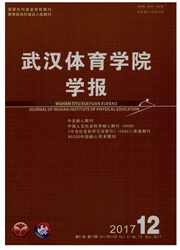

 中文摘要:
中文摘要:
目的:探讨运动性贫血的发生机理以及防治的有效方法。方法:本实验在动物实验基础上,从运动训练时间较长运动员的红细胞相关指标角度出发判断运动员的运动与贫血关系,并应用扫描电子显微镜(SEM)对运动性贫血组和对照组的红细胞形态变化特点进行观察。结果:贫血组运动员血红蛋白、红细胞数目、红细胞压积、MCHC指标显著低于同年龄和同性别对照组运动员(P〈0.05)或(P〈0.01),红细胞异常率显著高于同年龄和同性别对照组运动员(P〈0.05)或(P〈0.01);抗运动性贫血剂不同程度地提高血红蛋白、红细胞数目、红细胞压积、MCHC,红细胞异常率显著下降(P〈0.05或P〈0.01)。结论:抗运动性贫血剂通过改善红细胞形态,有效减少红细胞的老化,从而达到治疗运动性低贫血的目的。
 英文摘要:
英文摘要:
The purpose of this research was to explore the mechanism of sports anemia and to find effective methods in the prevention and treatment of sports anemia. Based on the animal experiment, this research investigated the shape of the red blood cells (RBC) relating to sports anemia and anemia countermeasures by using SEM. It was found that sports anemia caused a decrease of Hemoglobin, RBC, HcT, MCHC (p〈0.05,〈0.01), the abnormal rate of RBC was significantly higher in sports anemia group than in control group (p〈0.05,〈0.01). Anemia countermeasures raised the levels of Hemoglobin, RBC, HcT, MCHC (p〈0.05,〈0.01) and decreased the abnormal rate of RBC significantly (p〈0.05,〈0.01). It could be concluded that the abnormal rate and senility of red blood cells which were effectively regulated by the anemia countermeasures, thus the purpose of treatment of sports anemia was achieved.
 同期刊论文项目
同期刊论文项目
 同项目期刊论文
同项目期刊论文
 期刊信息
期刊信息
